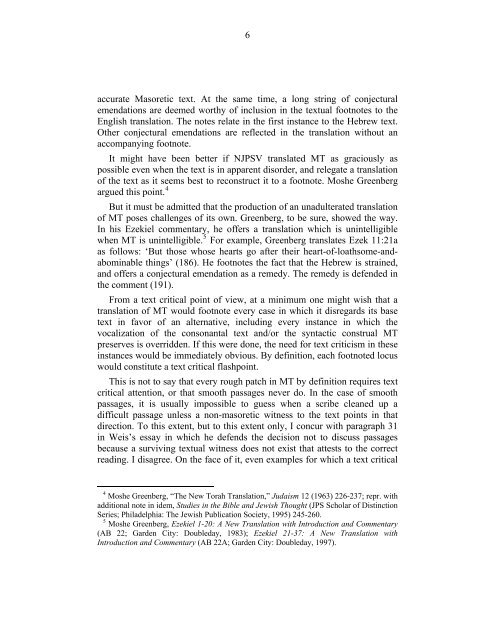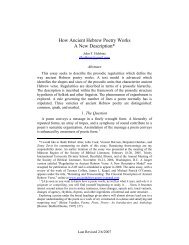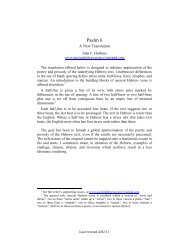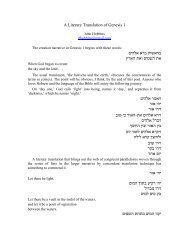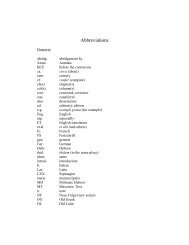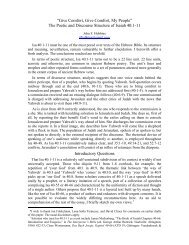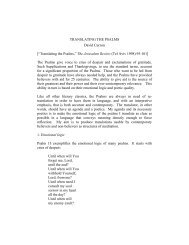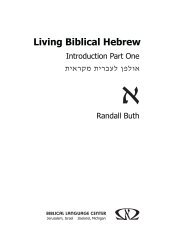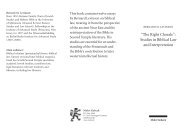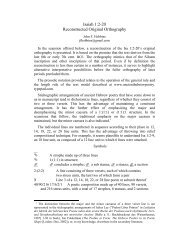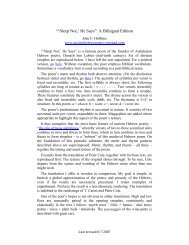Whither Biblia Hebraica Quinta - Ancient Hebrew Poetry
Whither Biblia Hebraica Quinta - Ancient Hebrew Poetry
Whither Biblia Hebraica Quinta - Ancient Hebrew Poetry
- No tags were found...
You also want an ePaper? Increase the reach of your titles
YUMPU automatically turns print PDFs into web optimized ePapers that Google loves.
6accurate Masoretic text. At the same time, a long string of conjecturalemendations are deemed worthy of inclusion in the textual footnotes to theEnglish translation. The notes relate in the first instance to the <strong>Hebrew</strong> text.Other conjectural emendations are reflected in the translation without anaccompanying footnote.It might have been better if NJPSV translated MT as graciously aspossible even when the text is in apparent disorder, and relegate a translationof the text as it seems best to reconstruct it to a footnote. Moshe Greenbergargued this point. 4But it must be admitted that the production of an unadulterated translationof MT poses challenges of its own. Greenberg, to be sure, showed the way.In his Ezekiel commentary, he offers a translation which is unintelligiblewhen MT is unintelligible. 5 For example, Greenberg translates Ezek 11:21aas follows: ‘But those whose hearts go after their heart-of-loathsome-andabominablethings’ (186). He footnotes the fact that the <strong>Hebrew</strong> is strained,and offers a conjectural emendation as a remedy. The remedy is defended inthe comment (191).From a text critical point of view, at a minimum one might wish that atranslation of MT would footnote every case in which it disregards its basetext in favor of an alternative, including every instance in which thevocalization of the consonantal text and/or the syntactic construal MTpreserves is overridden. If this were done, the need for text criticism in theseinstances would be immediately obvious. By definition, each footnoted locuswould constitute a text critical flashpoint.This is not to say that every rough patch in MT by definition requires textcritical attention, or that smooth passages never do. In the case of smoothpassages, it is usually impossible to guess when a scribe cleaned up adifficult passage unless a non-masoretic witness to the text points in thatdirection. To this extent, but to this extent only, I concur with paragraph 31in Weis’s essay in which he defends the decision not to discuss passagesbecause a surviving textual witness does not exist that attests to the correctreading. I disagree. On the face of it, even examples for which a text critical4 Moshe Greenberg, “The New Torah Translation,” Judaism 12 (1963) 226-237; repr. withadditional note in idem, Studies in the Bible and Jewish Thought (JPS Scholar of DistinctionSeries; Philadelphia: The Jewish Publication Society, 1995) 245-260.5 Moshe Greenberg, Ezekiel 1-20: A New Translation with Introduction and Commentary(AB 22; Garden City: Doubleday, 1983); Ezekiel 21-37: A New Translation withIntroduction and Commentary (AB 22A; Garden City: Doubleday, 1997).


